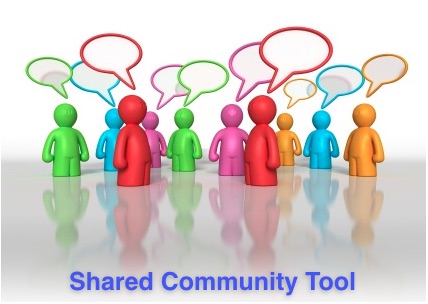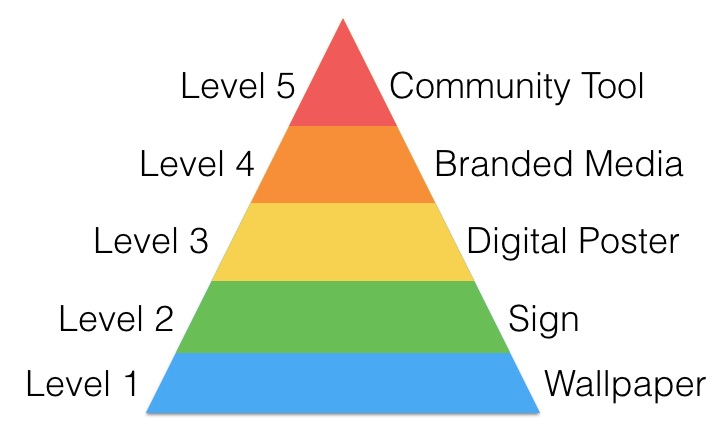
When we look at something in its most basic form, we also sometimes see it with new eyes.
This helps us put it into a bigger perspective.
By the end of this post, you will see how digital signage is not just about signs. It might play a very important role in the future of communication.
So What is Digital Signage?
Basically, it’s any display that can be used to show (or push) digital content.
- Here are some examples:
- a display with a DVD player showing a loop of content at a trade show, showroom or office entrance.
- a small display looping content from an SD Card or USB memory stick. This is called a Denshi POP and you often see them on the shelf in retail stores.
- a larger vertical display with special player hardware that receives content over the Internet. You often see these on pillars in train stations showing advertisements.
- an touch screen display in a shopping mall that shows a floor map. You can touch it and get information about the various shops and services available.
- a large outdoor billboard showing advertising like the big LED signs in front of Shibuya station.
- displays used for corporate communication in the lunch rooms or break rooms at each company branch.
We can summarise the various uses into four categories from simplest to more complex.
1. Digital Wallpaper: signage with no message
The most basic use of digital signage has no messages at all. It’s just part of the room design. You might even call it digital wallpaper.
There is no real message. It’s all about how it looks or how it adds to the atmosphere of the room.
In fashion brand shops you’ve probably seen a display with looping content showing models walking down a runway (wearing the brand clothing of course). For brands targeting younger customers, might see looping content of people surfing or snowboarding.
2. Digital Sign: one main message
The next level of digital signage has one main message or purpose. This is the closest use to an actual sign.
It might be used just to show the name of the shop, or it could contain the whole menu. It might just say “Sale” to let you there is a sale on.
It could point the way to a nearby store or show you a map (possibly interactive) with the store layout for a shopping mall.
3. Digital poster or digital billboard: a series of messages
The third level of digital signage uses the displays as digital versions of posters or billboards. Many of the big outdoor signs or displays in train stations are like this. They mainly show one Ad or a series of Ads looping.
The content is updated regularly, for example on a weekly basis. These signs are digital versions of posters and billboards and don’t do much more.
4. Digital Media: a branded communication channel
This is the fourth and highest level of signage that we typically see around us. Here, you can see a variety of different messages.
There might be some messages like weather or news that there for your information. There might be some messages that are funny for your amusement. And there might be Advertising mixed in as well.
In-store media across many locations would be a good example. Corporate communications in a company could be too, though probably without the advertising.

Five levels of Digital Signage content
5. Shared Community Tool: Beyond Media
Is there another level beyond digital media?
I think there is. There are not many examples of this now, but I think we will see some soon. At this level, the signage is not just a media, but an important tool of the community.
With Digital Media (level 4), someone is using the media for their own communication purpose, which might be advertising or getting staff on board with the corporate vision.
However, when signage becomes a community tool, the whole community is using it to reach a shared goal.
Imagine signs throughout a very small town, in shops and public areas, perhaps even homes. The tourist information centre in this town takes photos of participating visitors and shares them on the network along with their first names and hometown.
Now as they visit shops in the town, they see their photo and a welcome message. Shop keepers also recognise them and call them by name.
It works the other way too. The latest town happenings are shared on the media. Visitors get an instant insight into what’s happening in the town. They might well recognise some of the shopkeepers who are featured in the town news.
Here the goal is promoting the community and making it accessible to visitors.
Another example might be signage used as a corporate communication media across many company locations. Goals can be tracked and broadcasted on the screen.
It could be an important KPI (Key Performance Indicator) like sales or a CSR initiative such as a company wide effort to save energy.
If you saw a simple graphic several times per day showing the top 3 (and maybe the bottom 3) office locations ranked by how well they were achieving their goal, this would be a great reminder to stay focused on the goal.
This is the power of push information. It’s passive, but it’s there. People will take notice. Trying this with an email or Intranet can work too, but you need people to make the effort to open the email or go to the Intranet.
Digital Signage is not restricted to any one level
It’s important to remember that digital signage doesn’t have to be limited to any one level listed above. It can be attempting any number of them at the same time.
Currently, most signage is still various combinations of the lower three levels. The reason is clear.
Each of these are very easy to understand and have a clear analog alternative that they are emulating if not replacing.
Level four gets messy. This is new territory for us. We have to figure it out as we go along. There is no right answer, but best practices will slowly emerge.
The good news is that it doesn’t have to be hard. We can figure out what works for us and make it better as we go along.
Things will get really exciting though as we start to use digital signage as an effective community tool.
Just as our PCs and mobile phones have become indispensable tools of our digital world, I think we will see digital signage play an increasingly important role in the future.
That future will be created by all of us!
Not just the people creating digital signage services like me.
But, also by you.
Maybe you will be involved with put in some signs somewhere.
Maybe you will be involved with deciding what content to run.
Or, maybe you will be one of the many people just walking by and seeing the content.
We all play an important role, and that is the purpose of “Otegaru Signage”, this community. To create the future where signage is a useful and effective tool for businesses and communities.
Whether you are going to putting up more signs, decide what the content will be, or even if you are just using it (and you are already using it, even if you don’t realise it yet).
And, as we’ll see in future posts, some types of digital signage are more suited to this than others.
(Spoiler alert: Otegaru net is fantastic as a community tool)

Hi
Very interesting and practical article. Although I thought Digital Signage was not really fro me this article gave me some ideas on who i could use for my business, consulting.
Keep up the good work.
Warren
Hi Warren,
Thanks for your comment.
That’s exactly why I’m writing.
To get people thinking a bit more about how communication is happening in the places around them. I think before too long, many people will start to realise how under-utilised the communication potential of their physical space is. Also, how it can be used more effectively in combination with other communication channels such as mobile.